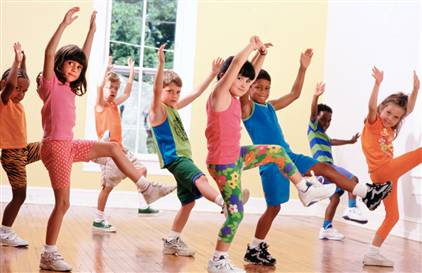Games
Training children between the ages of 6 to 10 years old can be challenging. Sessions have to be fun and children need to be empowered to take ownership. They need achievable goals and they must learn the purpose behind the exercises. With this formula they will enjoy the workouts, learn something every time, and look forward to coming back again. In part one of this article series I will talk about the importance of setting the tone for fun at the beginning of the session as well as specific games to accomplish your fitness goals.
Start the session by getting the children to laugh and look forward to the workout. Something as simple and predictable as high fives works every time. See how high they can jump. Try double or triple hit high fives. Another opener is to play follow the leader as they walk in the door. Tell them to follow you and imitate everything you do. Put your arms out and fly like a plane, do bunny hops, shuffle, crawl, throw your hands up in the air, and make funny faces. You can even have them take turns leading if they have been with you for a while. Treat this time like an ice-breaker to loosen up the children, physically and emotionally.
It is crucial that your age-appropriate fitness goals are embedded within a game. The games can be both competitive and cooperative. In competitive games, teaching children how to win and lose is critical for developing good sportsmanship and control of emotions. They can work together in cooperative games to accomplish a common goal and learn the value of teamwork.
Between the ages of 6 and 14, there are specific preferential adaptation windows (PAWs) in a child’s development during which they can more easily acquire new coordination skills. If you wait too long, those windows start to close (Drabik, 1996). Design a program that covers all the fundamental movement categories, but that has an emphasis on the developmentally appropriate skills for the age groups you are working with.
Obstacle Course – Movement Efficiency, Spatial & Body Awareness
An excellent way to improve a child’s efficiency of movement, spatial awareness, and ability to transition form one task to another is to set up an obstacle course in which they have to follow a set course within a set time. The course could consist of crawling under various sized hurdles, running through cones, pulling a rope, throwing med balls, and sprinting home.
Crawl & Skip Relay Race – Rhythm
If the goal is to work on rhythmic motion with reciprocal arm and leg movement, endless marching and skipping is tedious; but doing a crawl, skip and shuffle relay race is competitive and fun. This additionally enhances their ability to work on transitions that emphasize balance, spatial orientation, and body awareness, as well as overall agility.
Bear Crawl/Crab Walk Soccer – Core Stability, Shoulder Joint Integrity, Reaction
Set up 2 cones as a goal at each end of the field 10 to 20 yards apart. Use a soccer ball or a slower moving ball with more weight for younger kids. Have them start out bear crawling (knees off the ground at all times) and using hands only to score a goal. On your command have them switch to a crab walk and use feet only. The first team to score a set amount of points wins.
Hop N’ Toss – Dynamic Balance
To improve dynamic balance, have children stand side by side while hopping on one foot and tossing a ball back and forth to each other. To win they must get 10 catches and advance 5 yards within 20 seconds.
The key to keeping children engaged and coming back for more is to make it fun! Set the tone the minute they walk in the door and bring them up to your level of enthusiasm. Continue the workout in the form of games that will address all your fitness goals and teach competition as well as cooperation. In part two, I will discuss the importance of children taking ownership of their sessions and how it can be achieved through the technique of peer coaching.
References: Drabik, J., Ph.D. (1996). Children & Sports Training: How Your Future Champions Should Exercise to Be Healthy, Fit and Happy. Island Pond, VT: Stadion Publishing Company, Inc.
Craig Valency, MA, CSCS, president and co-founder of SPIDERfit, has been a personal trainer for the last 11 years. He is currently working at Fitness Quest 10 in San Diego, an elite personal training and athletic conditioning facility. He specializes in youth strength and conditioning programs that promote physical literacy, injury prevention and optimal performance. Along with training youths from 6 to 18 years of age for general fitness, Craig has also worked with some of the top junior tennis players in the world. He has been a physical education consultant for the Stevens Point school district in Wisconsin for the last 3 years, helping revamp the district wide programming for the K-12 PE curriculum. Craig earned his bachelor degree from UCLA, and Masters Degree in Kinesiology from San Diego State University.





Connect with SPIDERfit!